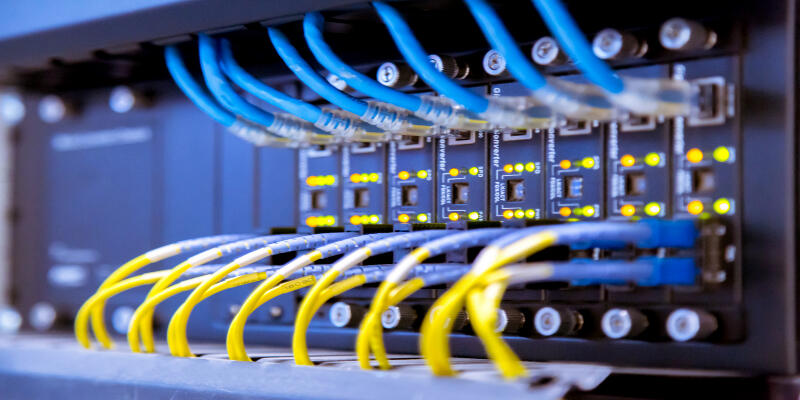Disclaimer: This post may contain affiliate links, meaning we get a small commission if you make a purchase through our links, at no cost to you. For more information, please visit our Disclaimer Page.
Using Ethernet cables ensures a faster and more stable internet connection. For those of you with a desktop computer set-up or a gaming console, you will want the speed and reliability of an ethernet connection to your internet. Wi-Fi can sometimes experience blocks and restrictions, whereas when you are plugged into your network using these cables, you are always connected to the internet with no problem.
The differences between blue and yellow ethernet cables link to whether they are for terminal server connections or power over ethernet (POE). The outer colors of these cables do not suggest differences in their functions, such as speed and reliability, but more for their purpose and use within an internet set-up.
Many newer laptops are no longer made with ethernet connection ports built in. However, you can buy a USB converter, which will allow you to plug in your device to your internet router using an ethernet. You can find these here.
Table of Contents
What is a yellow ethernet cable used for?
Yellow ethernet cables are used to connect an internet connection with a device. They work by plugging your networking device into your computer.
The cable creates an electric current between the two, carrying the internet to your device. This is quite different from Wi-Fi and some people choose to use this set-up as a backup option to ensure they are always connected.
Yellow ethernet cables are mainly used for Power Over Ethernet (POE). This means that your cable can supply both the electrical power and the data in one connection. This technology became widely used in 2009 and the color of these cables started as yellow.
In contrast, a LAN network requires an ethernet cable plus a power cable for your internet to be fully functioning on your device. The benefit of POE means that, by using just one ethernet cable to supply both the power and the data, you have reduced cabling requirements which is a much more preferred way of setting up the internet.
You can set up POE connections in your home as a way of keeping your cabling use to a minimum. This means that you can set up internet throughout your house with the need of only a few power supplies.
As times have moved on, ethernet cables now all more or less have the same functions. Therefore, the different colors mean little nowadays as they did when tech industries were first inventing them.
However, it is important to be aware of the slight differences in functions as you may stumble upon the different tech vocabulary in your internet setup.
When buying your internet router, it is always important to check with the providers that you have the correct cabling to ensure you are ready to get and stay connected.
You will need to consider the type of device you are looking to connect to, and if ethernet internet is necessary or if you can just use Wi-Fi.
Remember that you will have a much more stable connection using an ethernet cable. This is important to consider when setting up a home office or for gaming consoles. Wi-Fi is sometimes not strong enough to support these kinds of functions.
For larger office spaces and public areas, ethernet cables are also recommended depending on the type of connection that is required.
Some offices choose to set up both ethernet cables and Wi-Fi for people to use desktops and their laptops to complete work. However, this is where you will be looking at setting up a LAN network which you can find out more on next.
What is a blue ethernet cable used for?
Blue Ethernet cables allow internet connection and network set-up between devices. Similar to yellow ethernet cables, blue ethernet cables act as a current between the two and work by plugging into the ethernet receiver ports on each device.
As mentioned above, there are not many significant differences between the varying colors of ethernet cables as technology has developed rapidly in the past decade. This means that many of the functions of the different types of ethernet cables have now been adapted and produced as the standard. Therefore, the colors do not make much of a difference anymore with our modern internet set-ups.
With that, it can still be useful for you to know what the slight differences are. Blue ethernet cables are usually used for something called a terminal server connection.
This will enable multiple systems to connect to a LAN network, such as in an office space, or office building. A terminal server connection means that there is no need for a modem or router.
Terminal server connections are widely used in larger spaces as they allow for many devices to connect to the LAN network (internet). This works as a remote access service which is ideal for large companies looking to share the same network among all employees.
What is the difference between blue and yellow ethernet cables?
As we have now looked at the different functions of blue and yellow ethernet cables, we can now look at what the differences are.
There are very few differences between these two ethernet cables, based solely on their coloring. In many internet set-ups that require you to use an ethernet cable, you can use either and they will both deliver the same result.
Different color cables are usually used to make different types of network hardware more recognizable. Such as the differences stated above with POE and terminal server connections.
Different colors used in these cables can also be used to distinguish different company’s produce. It is important to remember that the jacket color of these cables does not imply any difference in their functions.
This meaning that they all work in the same way regardless of their outer color.
Which ethernet cable category is best to use?
There are four main ethernet cable categories used widely today. These categories are Cat5, Cat5e, Cat6, and Cat6a. However, these categories are not assigned to a specific color.
As mentioned above, the colors can help distinguish between the cable’s use and the purpose of the connection, as opposed to its actual function.
Ethernet cables within these different categories will more than likely be marked. For example, a Cat5 ethernet cable will be marked with ‘Cat5’ and so on. Depending upon what your intended use if for your ethernet cable, Cat5e is an adequate category to use for domestic internet.
This is the best choice in terms of cost and performance. However, it is important to consider that within future years of technology evolution, this cable may start to limit your internet speeds as they inevitably increase.
Therefore, if you know you will be downloading and transferring many large files, then consider upgrading your ethernet cable.
Cat6 and Cat6a are more than likely the best cables to use for ensuring you have great internet speed. These cables do not have a major difference in price to the Cat5e cables and so for future internet use, they are a good investment for your set-up.
For office use and larger network activity, consider higher categories such as Cat7. Although Cat6a will be adequate for this kind of network. But again, it depends on the size of files being used as with time the lower categories will struggle to support this.
Cat5 is best to avoid as it is obsolete in its use now against our newer internet set-ups.
For gaming and other such online entertainment, this cable will not support your speeds and downloads and so you will struggle with your connection which can, in turn, be frustrating and difficult.
Conclusion
The differences in ethernet cable coloring are not to distinguish the functions of the cable but to help differentiate between their purposes.
It is the categories of ethernet cables that deliver the slight differences in how these cables do function. Such as their speeds and their download size.
Be sure to always check with your internet providers which cables are best to use, and understand that for domestic use of the internet, you do not need to use the highest category of ethernet cable on the market.
Cat5e or Cat6 will be sufficient for you. Yet, with much larger internet use, consider purchasing the higher categories to ensure future-proofing your internet connection.


